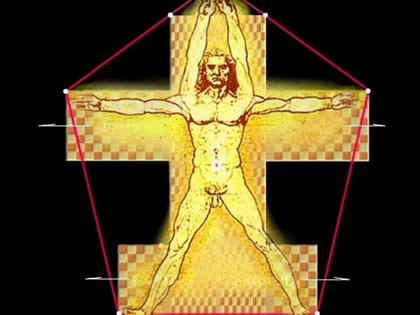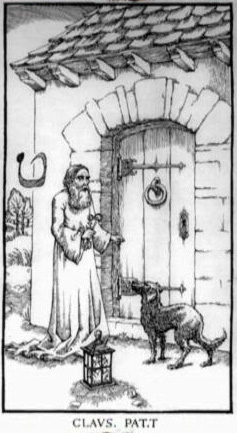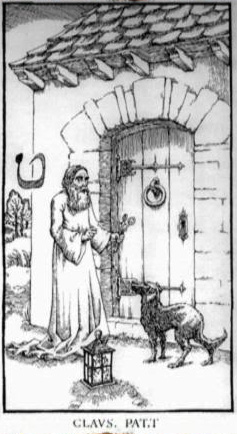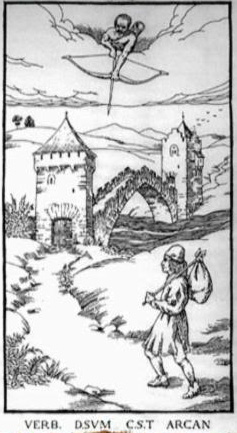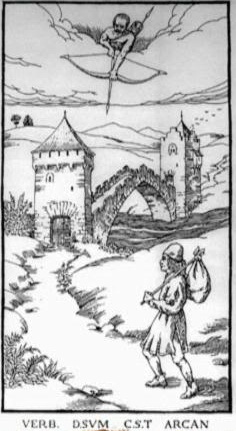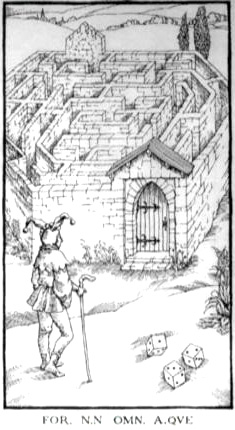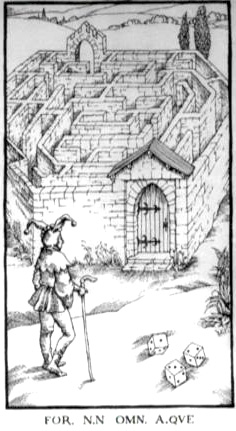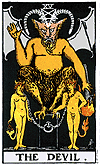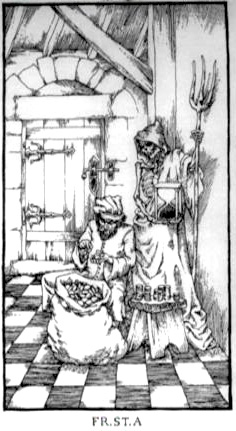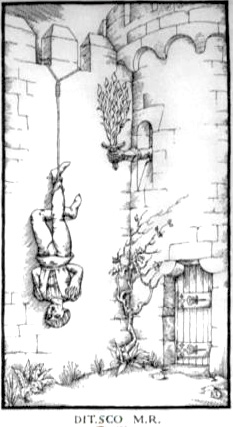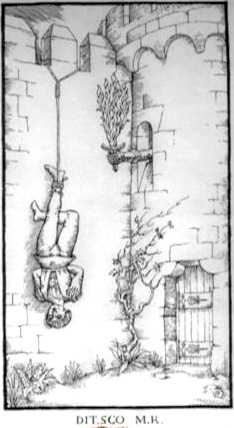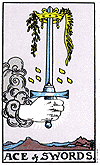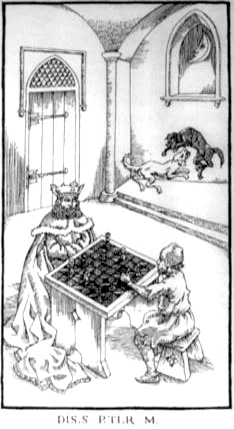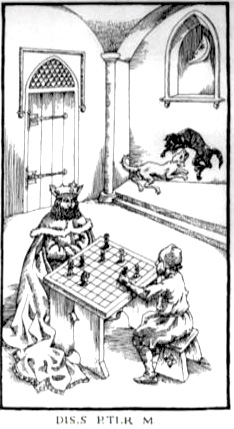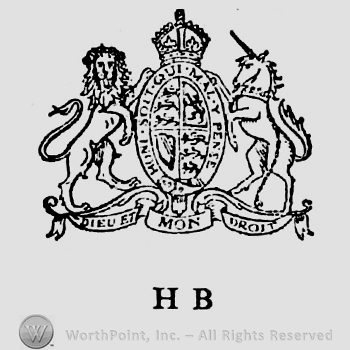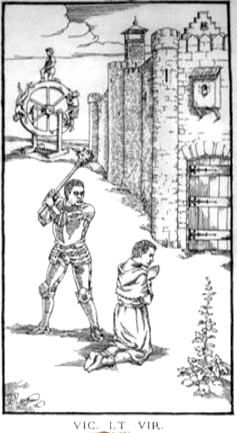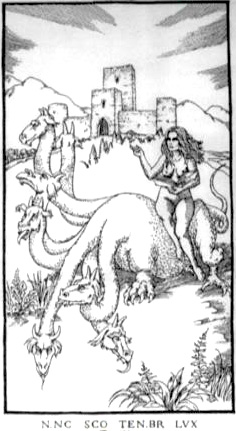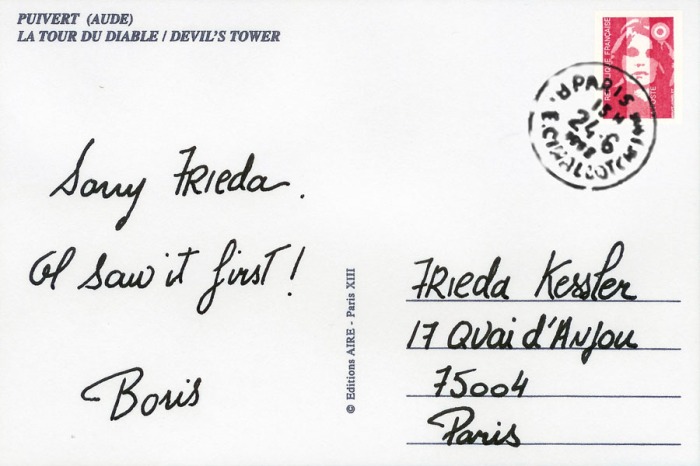|
|
Post by Goldenfleeced on Aug 27, 2013 23:44:09 GMT
I've really been wanting to bring this particular piece of media ('The Ninth Gate,' by Roman Polanski) into 'the picture' for a while now, but I've held off, mostly due to the fact that it wasn't directly concerned with Masonry, per se, and yet... we will find the symbolism that is employed in the movie to be at least indirectly related to such topics as have been covered here as alchemy, and other miscellania... I find many of the points to be quite serendipitous, to say the least, as well as 'educated' in their employment at times... lol... While there are many angles from which we could approach this, I have decided that I will present the illustrations from the purported 'book' that the movie is based on, the De Umbrarum Regis Novum Portis, translated as 'The Nine Doors To the Kingdom of Shadows,' or 'The Nine Gates.' To begin with, we know that the number Nine symbolizes 'completion,' among other things. We may infer then, that passing through this 'Ninth Gate' will mark the 'completion' of something... sort of a 'passing of degrees,' if you Will... and then, there's this, that I thought was interesting under the circumstances... The spiritual meaning of number Nine bring us to the very height of vibrational frequencies in this number sequence. Nine represents attainment, satisfaction, accomplishment, and our success to achieve an influence in our circumstances. The spiritual meaning of number Nine deals with intellectual power, inventiveness, influence over situations and things.www.whats-your-sign.com/spiritual-meaning-of-numbers.htmlTo begin with, the illustrations seem to represent a 'puzzle,' or a 'message,' of sorts... and the true Seeker is 'rewarded' with the most 'serendipitous' help of... someone... a 'student,' who wears sneakers and likes 'books,' as it so happens... (and what did Saint-Martin have to say about 'books?' That's right...) Oh, yes... and Saint Martin even snuck into the movie...  It is quite the 'challenge' to the understanding... in the first place, you may never understand whether she stands in the place of 'good' or 'evil,' or whether she actually incorporates both principles. While it seems that she never directly brings circumstances about, she does most certainly make the most of circumstance as it presents itself, without apology or second thought. It is as it should, or must, be... and, I might add, she wears the Mona Lisa-like smile of the Sphinx. A 'knowing' smile, which is not altogether warm, nor indeed even 'happy,' but... satisfied. The first illustration shows a knight on his horse, who, with his finger on his lips, counsels 'Prudence,' or 'Silence;' another translation of the latin text is: Only one who has battled according to t he rules will prevail. The castle in the image is his destination, and it is fortified with towers... four in one illustration, and three in the other. Now, that's odd... the 'knight' is on a quest, like Parzival... coincidentally... lol... To complete the 'tour' (which is another way to say 'tower,' which adds a whole new level to the 'riddle') is the knight's quest... speaking of 'romances' and all... Well, there you go... building towers is definitely Masonic... totally... I mean, truly... But I digress...  Four represents matter, and three represents spirit... two different destinations possible for the same 'questor.' And what have I always said...? Winners never cheat, and cheaters never win... that would seem to be right, after all... And then, there is this... To know, to will, to dare, and to be silent... Silence is Golden... and there's our dear friend Prudence... Here are the illustrations... And here is a card from the Marseilles tarot deck... I left this out of the original post, but I can tell you this... in the Marseilles deck, there are four mounted riders, such as this, except that... three are riding blue horses, and they all face forward; this card alone of the four shows the chevalier mounted on a white horse, and not only that, it is the only 'rider' or 'horseman' that is turned to face the 'observer,' as is the rider in the illustration above. He turns to the observer to either issue the injunction; 'Silence is Golden'... or perhaps to signify that he received it. And, oh yes... the wand is 'sprouting;' check the Ace. Definitely sprouting... signs of new growth. I will follow this with my other posts, as I can get them put up, and I hope that this might at least spark some conversation, or... that you'll at least be entertained. I may, and will try to, add things to these original posts as I put them up here, just so that you will have the satisfaction of at least a little something new for your trouble, if you were one of the readers at the other forum, but also... you should have the opportunity to tell me what a nitwit you think that I am; that should be some sort of an incentive to readership, I would think... and there are 'gifts' and things on these forums, if all else fails... I have the power...  Read more: innerchamber.proboards.com/thread/644/entering-ninth-gate?page=1#ixzz2dDLdNHzV |
|
|
|
Post by Goldenfleeced on Aug 27, 2013 23:50:16 GMT
About the number Nine, generally...
The fact that we see the number nine associated with the creation of Adam (man) suggests more than just a passing relationship.
Mispar katan is a form of gematria that pursues the "root" of an idea by reducing a gematria to a number less than ten. This form of gematria is called small values; with all tens and hundreds reduced to 1 - 9 by summing the digits.
Consider that the summing the digits of the numbers represented by the Hebrew letters of the name “Adam” (אדם), results in the number nine. Nine is called the mispar katan (literally, "small number") of Adam, which alludes to the essential quality of man:
א = 1
ד = 4
ם = 40
--------
Total: 9
The Gemara teaches us that whoever prays on the eve of Shabbat and recites vayechulu, it is as if he is a partner with HaShem in the act of creation. It is noteworthy that the word vayechulu in mispar katan equals nine. Shabbat in mispar katan equals nine, and the word emet, truth, in mispar katan equals nine. Thus, one who recites vayechulu is testifying to the truth that HaShem created Adam and the world in six days and that HaShem rested on Shabbat.
Unbelievably, we find that any number times nine equals nine (18, 27, 36, 45, 54, 63 etc), in mispar katan. The reason being that the pasuk says: Mishlei (Proverbs) 12:19 The lip of truth (Emet) shall be established for ever; but a lying tongue is but for a moment.
Emet, truth, lasts for ever. Therefore every multiple of nine remains a nine. Truth always remains the same and can never be altered. Similarly, HaShem is true from beginning to end.
Adam is also in mispar katan gematira nine, for he alone from the entire universe was graced with the seal of truth from his Creator.
Adam was crowned with glory and honour (Psalms 8). Which could be interpreted as tefillin (which are imprinted with the Shin)--convert the word "Shin" to its mispar katan and you also get nine! (shin=300 yud=10 nun=50 combined sum is 360 = sum of the digits is 9!). tefillin are kept in the form of the faithful and loyal dove, symbolic of emet=441 sum of digits is nine!www.betemunah.org/nine.htmlRead more: innerchamber.proboards.com/thread/644/entering-ninth-gate#ixzz2dDU6KW4R
|
|
|
|
Post by Goldenfleeced on Aug 27, 2013 23:59:54 GMT
I'm going to go ahead and tell you that the point of the book/story seems to be just as it was stated: 'To raise Lucifer.' The story tells us that the 'devil-worshippers' understand this to mean one thing, but that the 'truth' of the statement may go to another end altogether, which explains the 'surprise' on the part of the 'followers of Lucifer' when nothing turns out exactly as any of them had expected, or 'purposed,' that it might. Contemplate that... and then go on with the interpretations of the illustrations; there is much symbolism hidden here, that really bears your attention. The second illustration shows obvious connections with the 'Hermit' of the Tarot; this one holds two keys... (remember our Lady of the Hermits? lol...) evidently, 'enlightenment' stands at the door. There is a lantern on the ground, and a letter drawn that looks like the Hebrew letter Tet. Open that which is Closed... The keys are held in one case, in the right hand, and in the other, the left... that seems obvious enough. And yet, there are hidden allusions to the two doors to Solomon's Temple, and the two doors to the Oracle. Now, as to the inclusion of the letter 'Teth/Tet'... this is 'serendipitous,' to say the least, but... what did you really expect?  Tet: Introversion - the Concealed GoodThe tet is the initial letter of the word tov, "good." The form of the tet is "inverted," thus symbolizing hidden, inverted good--as expressed in the Zohar: "its good is hidden within it." The form of the letter chet symbolizes the union of groom and bride consummating with conception. The secret of the tet (numerically equivalent to nine, the nine months of pregnancy) is the power of the mother to carry her inner, concealed good - the fetus - throughout the period of pregnancy.
Pregnancy is the power to bring the potential to actualization. The revelation of new, actual energy, the revelation of birth, is the secret of the next letter of the alef-beit, the yud. The yud reveals the point of "Essential Life" as realized in the secret of conception of the chet and carried, impregnated, in the tet.
Of the eight synonyms for "beauty" in Hebrew, tov--"good"--refers to the most inner, inverted, and "modest" state of beauty. This level of beauty is that personified in Torah by Rebecca and Bat Sheva, who are described as "very beautiful [goodly] in appearance."
At the beginning of Creation, the appearance of light is termed "good" in God's eyes: "And God saw the light was good." Our Sages interpret this to mean "good to be hidden for the tzadikim in the Time to Come." "And where did He hide it? In the Torah, for 'there is no good other than Torah.'"
The Ba'al Shem Tov teaches that the "Time to Come" refers also to every generation. Each soul of Israel is a potential tzadik (as it is said: "and your people are all tzadikim"), connected to the goodly light hidden in Torah. The more one actualizes his potential to be a tzadik, the more goodness he reveals from the Torah "womb."
In the first verse of the Torah - "In the beginning God created the heavens and the earth" - the initial letters of "the heavens and the earth" spell God’s "hidden Name" in Creation (alef-hei-vav-hei), according to Kabbalah. The numerical value of this name is seventeen, the same as that of the word, tov, "good." The word tzadik equals 12 times 17 = 204, the total value of the twelve permutations of the four letters of this hidden Name. Tzadikim, who are called "good," possess the power of the hidden Name (derived from "the heavens and the earth"), the hidden goodness needed to unite heaven and earth and thereby reveal the inner light and purpose of Creation. Just as the alef possesses the power to bear opposites - the power of the firmament to join the higher and lower waters together - so does the tet possess the power to unite the upper and lower worlds, "heavens and earth." Chassidut teaches that in the service of the soul, this power is manifest in man when he assumes the state of being "in the world yet out of the world" simultaneously. To be "in the world" means to be fully consciousness of worldly reality in order to rectify it. To be "out of the world" means to be fully aware that in truth "there is none other besides Him."www.inner.org/hebleter/tet.htmKnock, and it will be opened unto you... Read more: innerchamber.proboards.com/thread/644/entering-ninth-gate#ixzz2dDVBLcIP |
|
|
|
Post by Goldenfleeced on Aug 28, 2013 0:08:01 GMT
The third illustration is interestingly titled, ' Wasted Breath Keeps a Secret'... now, just how many times have I been told that? But... yes... right... I understand that another transliteration of the latin title could be ' a missing word keeps a secret.' Now, you see... that sounds like the 'missing word' of Masonry to me. And then there are two pillars, or towers... better still... I can make this work...  Anyway, the 'traveler' in this case is depicted very nearly as the Tarot's 'Fool,' except that he left his dog with the hermit in the last illustration; maybe the dog is hoping for some crumbs from the master's table, at least... lol... From a superior position of hiding, in the clouds above, an archer (that bears no resemblance at all to Cupid) takes aim at the hapless 'fool,' who seems to suspect nothing. In one illustration, the arrow being shot is the only arrow available to the archer... his quiver is empty. He has 'one shot' at the fool, and that's it. In the second picture, there is yet an arrow left to the archer, shown in the quiver point up. Which is odd, because that's not how you want to pull an arrow out of a quiver, you know... point up... even a girl could tell you that...  So... why? It appears to me to be really just a horribly perverted case of attempting to 'shoot the messenger?' Lol... Well... just sayin'... take your best (or only) shot, I guess.  And, it could be that in his arrogance at taking the 'easy shot' at the poor fool, he has overlooked the position of the arrow available to him... and that he will be wounded with his own weapons, so to speak... taken in his own devices. I really wouldn't be at all surprised. Of course, if he opts not to use the arrow, then it won't matter... but only if he chooses not to use it, it looks like. Ouch...  Read more: innerchamber.proboards.com/thread/644/entering-ninth-gate#ixzz2dDXDsBby |
|
|
|
Post by Goldenfleeced on Aug 28, 2013 0:14:59 GMT
Number Four tells us that 'Chance is Not the Same for All'... and that is also the truth, I'm afraid. For all, there is 'chance,' but not the same chance (oh, you can say that again)... there are determining factors that are beyond 'chance,' even though the odds of their coming together in the right proportions, at the right time, may seem to defy 'chance.' If you see what I mean...  What seems like 'chance' is actually that 'planned randomness,' or serendipity (as I like to call it) at work... the word 'planned' is important, though; it means that you can smile through the 'accidents,' because it was really meant to be that way. See the jester...? It's an April Fool... lol... sorry; serendipity again. He seems to be in possession of a shepherd's crook, for a staff... You see that he stands before a maze, or labyrinth... of masonry, or brick-work... and not the garden variety hedge-row maze. I liked that detail... it is a 'construction,' you see; and, the labyrinth is, of course, a path that has to be made... a puzzle to be solved. The 'thread of Ariadne' was needed, I believe, to conquer the labyrinth; in other words, somebody had to unravel their sweater... hahahaha... Three dice lay on the ground, showing the numbers one, two and three... In one illustration, the exit is open; in the second, it is bricked over, or sealed. Entrapment, or escape... The dice equal 6, the number of 'man,' or 'the sign of the devil;' the total of the three dice is 18 or 9... again... and the reverse image of 6. Well, well, well... Read more: innerchamber.proboards.com/thread/644/entering-ninth-gate#ixzz2dDZQcWD9 |
|
|
|
Post by Goldenfleeced on Aug 28, 2013 4:07:16 GMT
Continuing with illustration number five... This one is interesting, as it is titled ' In Vain'... Here, we see a 'merchant' with a large bag of 'gold,' or 'riches,' I suppose... the 'bad news' is that the 'Reaper' is looking over his shoulder, and he holds an hourglass in his hands (the hourglass of the 'black widow,' maybe? May be...). In one, there is sand running in the hourglass... in the other, there is not. Time is up... We see that the 'Reaper' in this case is holding a trident/pitchfork, which is an odd tool for someone that prefers a scythe... however, the trident is the sign of Neptune, whose card I showed you in the first post, I believe... most coincidentally, really...  It must mean something, in light of the 'reaper' symbolism, and the 'end of time,' which brings us to the seventh angel of the 'apocalypse' who declares that 'there should be time no more.' It stands with one foot on the land, and one foot on the sea, if you will remember... something like Merovee might have, I imagine... and the scene seems to be playing itself out on the Masonic checkerboard. You have gathered in vain... Read more: innerchamber.proboards.com/thread/644/entering-ninth-gate?page=1#ixzz2dEWEu1N4 |
|
|
|
Post by Goldenfleeced on Aug 28, 2013 4:17:54 GMT
In illustration number six (6), ' I enrich myself with Death.' Now, aside from the obvious identification with the 'Hanged Man' of the tarot, there seems to be a second card at work here... the Ace of Swords, but it is engulfed in flames. Hmmmm... we'll look into that. Let's begin with the number 6... the 'sign of the devil,' if you Will, and see what some of its connections are... and there's one now...  6 is the smallest positive integer which is neither a square number nor a prime number. Six is the second smallest composite number; its proper divisors are 1, 2 and 3. (Shown on the dice in the previous card...) 6 is the smallest positive integer which is neither a square number nor a prime number. Six is the second smallest composite number; its proper divisors are 1, 2 and 3. (Shown on the dice in the previous card...)
Since six equals the sum of its proper divisors, six is the smallest perfect number...
As a perfect number:
6 is related to the Mersenne prime 3, since 21(22 - 1) = 6. (The next perfect number is 28.)
6 is the only even perfect number that is not the sum of successive odd cubes.
As a perfect number, 6 is the root of the 6-aliquot tree, and is itself the aliquot sum of only one number; the square number, 25.
Six is the only number that is both the sum and the product of three consecutive positive numbers.
Unrelated to 6 being a perfect number, a Golomb ruler of length 6 is a "perfect ruler." Six is a congruent number.
Six is a unitary perfect number, a harmonic divisor number and a highly composite number. The next highly composite number is 12.
5 and 6 form a Ruth-Aaron pair under either definition.en.wikipedia.org/wiki/6_%28number%29 That's not so bad, for being the 'sign of the devil,' do you think...?  Or, an 'only begotten,' maybe, in a way, since, as we have just shown, it is the ONLY number that is both the sum and the product of three consecutive positive numbers... 1, 2, and 3... now, that sounds familiar, somehow... Another story tells us that the Norse god Odin hung upside down from the world-tree, Yggdrasil, for nine days in order to attain wisdom... in other words, he had to 'turn his world upside down' and forget everything that he thought that he knew previously, sacrificing his own 'knowledge' for that which is 'perfect.' By passing through these nine days of challenge, or nine 'gates,' possibly, Odin acquired the runes from the Well of Wyrd, the source and end of all sacred knowledge. Well, well, well... how do you like that?  Odin (Woden to the Anglo-Saxons) is a god of the mysterious realms of wisdom, cunning, sorcery, and death. Subtle, aristocratic, and at times inexplicable, Odin is the literal father of important gods, such as Thor, and All-Father to the whole of creation, divine and human. Amongst his gifts to us, his children, was the greatest of all: the gift of writing. To accomplish this Odin hung himself upside down upon the World Tree, the gigantic ash Yggdrasil ( a compound meaning "terrible horse"). After nine days of fasting and agony, in which "he made of himself a sacrifice to himself", he "fell screaming" from the tree, having had revealed to him in a flash of insight the secret of the runes. Their initial manifestation took the form of eighteen powerful charms... Odin (Woden to the Anglo-Saxons) is a god of the mysterious realms of wisdom, cunning, sorcery, and death. Subtle, aristocratic, and at times inexplicable, Odin is the literal father of important gods, such as Thor, and All-Father to the whole of creation, divine and human. Amongst his gifts to us, his children, was the greatest of all: the gift of writing. To accomplish this Odin hung himself upside down upon the World Tree, the gigantic ash Yggdrasil ( a compound meaning "terrible horse"). After nine days of fasting and agony, in which "he made of himself a sacrifice to himself", he "fell screaming" from the tree, having had revealed to him in a flash of insight the secret of the runes. Their initial manifestation took the form of eighteen powerful charms...
I know that I hung on a windy tree
nine long nights,
wounded with a spear, dedicated to Odin,
myself to myself,
on that tree of which no man knows
from where its roots run
Odin's fabulous grey horse Sleipnir ("Slippery One") was like no other. This is the eight-legged horse depicted so beautifully on the painted stones of Gotland, a now-Swedish island in the Baltic. Sleipnir was the offspring of a giant's magical stallion and the "trickster" god, Loki, who disguised himself as an alluring mare to distract the stallion from the task of building a wall around Asgard, home of the Gods. If the wall had been completed by a certain date, Freyja, the goddess of beauty, war and sexuality would have been forfeit to the giant as payment for his labours. (The gods also stood to lose the Sun and the Moon, but did not seem particularly concerned about their impending loss)
Loki was successful, but vanished for a few seasons as he had to bear the fruit of his trickery. He returned to Odin leading his equine offspring, which he presented as a gift. With his eight legs, Sleipnir could run twice as fast as ordinary steeds, and it is he who carries the valiant dead from the battle field to Valhalla.www.octavia.net/vikings/odin.htmI know this won't mean anything to you, but 'Odin' anagrams to 'Dino'... it is meaningful to me.  Anyway... I enrich myself with Death... now, about that flaming gauntlet... Basically, the Ace of Swords has the meanings of: MENTAL FORCE-TRUTH-JUSTICE-FORTITUDE The Ace of Swords is a symbol of possibility in the area of intelligence, reason, justice, truth, clarity and fortitude. In readings, it shows that a seed of clear understanding has been planted in your life although you may not yet recognize it. When the seed sprouts, it could take almost any form. It might be a compelling idea, desire for the truth, call to justice, or a need to be honest. On the outside, it could be an offer, gift, opportunity, encounter or synchronistic event.
Sometimes this Ace stands for a challenge that will test you in some way. Life never goes smoothly for long. Sooner or later a hurdle shows up, and the Ace of Swords can tell you when one is coming. This card is also a reminder to you to face your challenge, whatever it is, with courage, honesty and a firm resolve. In every challenge, there is opportunity.www.learntarot.com/sa.htmA gauntlet, indeed... and set ablaze, at that... Read more: innerchamber.proboards.com/thread/644/entering-ninth-gate?page=1#ixzz2dEXe8CTv |
|
|
|
Post by Goldenfleeced on Aug 28, 2013 4:46:56 GMT
Now, we're getting somewhere, maybe...  The next illustration is one of my personal favorites... it is Number Seven, and is titled, most serendipitously, ' The Disciple Outshines the Master.' Outshines... as in the sun, maybe? The symbolism seems to indicate moonlight, but how would the moon outshine the sun? Venus once outshone the Sun, I understand... I only wonder that they didn't say 'apprentice,' but how obvious do you want to be, anyway? As it is, I think we can easily make that leap... A king plays a game of chess with a 'beggar'... strange competitors... but look at the boards that they are playing on; one is all white squares, and one is all black. Winning and losing seems to be fairly 'relative' under the circumstances, I would think... since in either case, your 'moves' don't seem to be nearly as critical as merely 'getting to the other/opposite side.' The crescent moon that seems to be watching through the window may symbolize new beginnings and the turning of dreams into reality... or... John the Baptist is sometimes connected with the waning moon (Baptistry of Östr Hoby, Sweden, 12c) to explicate his role as the last prophet of the waning Old Testament which is regarded, simultaneously, as a promise of the New Testament. The moon contrasts here the sun as symbol of fulfillment, in other words, the New Testament, more specifically Jesus Christ himself, the sol invictus. The same contrast is used to signify ecclesia and synagoga. The latter is identified with the symbol of the waning moon.
Mary as the God-bearer is identified with ecclesia. She is standing on the waning moon which points out that the Old Testament and synagoga are the foundations of the Church. No doubt that we have here also the idea of victory of ecclesia over synagoga. The motif of the luna is very old (~820, MS 99 Paris, Valenciennes) and is not used in the beginning as an attribute of Mary but of the Church. It is only in the 14/15c that a lateral transfer takes place, meaning Mary occupies now in iconography the place of the Church and inherits some of its attributes. The Katharinenthal Gradual of 1312 shows an image of transition, where the same feminine figure contains or bears the attributes of the Church, Mary and the Apocalyptic Woman. The figure stands on a personalized half moon. It is true that the visual elements, half moon, stars, sun, are borrowed from Revelations 12,1. Early representations of Ecclesia (10-12c) show her as the apocalyptic woman with the dragon. The motif of the apocalyptic woman is applied in a variety of ways to Mary. [Trier]
There exists, beginning around 1348, a type of Marian sculpture called Madonna standing on the crescent moon (Mondsichel-Madonna) where the reference to the apocalyptic woman is largely dissociated from the use of the moon symbol (for example, wooden sculpture, Trier, 1480). It sometimes opposes -- in representations of the Platytera -- the sun born from Mary and the human race in need of salvation (moon) (Katharinenthal, 1312). The crescent moon is used in representations of Mary's miraculous conception and birth (Joachim and Anna at the Golden Door, da Camerino, Tadino, ~1470). The crescent appears under Mary's feet in paintings of the Assumption (Meister of the Luzien-Legende, 1485) and signifies her glory and victory over time and space.campus.udayton.edu/mary/questions/yq/yq244.html Now, as to the two dogs shown fighting under the moon... Well, now, that looks familiar... 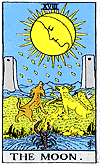
Most of the time we live in a tiny pocket of normality that we wrap around us like a security blanket. We turn our backs on the mysterious universe that waits outside. From time to time we may sneak a peak with our imagination, or venture out through fantasy or expanded awareness... The Moon is the light of this realm - the world of shadow and night. Although this place is awesome, it does not have to be frightening. In the right circumstances, the Moon inspires and enchants. It holds out the promise that all you imagine can be yours. The Moon guides you to the unknown so you can allow the unusual into your life.
Sadly, we are usually afraid of the Moon. In readings, this card often stands for fears and anxieties - the ones that come in the darkest part of the night. Card 18 also stands for illusions. It is easy to lose our way in the moonlight. Be careful not to let deceptions and false ideas lead you astray. Sometimes the Moon is a signal that you are lost and wandering aimlessly. You must find your way back to the path and your clarity of purpose.www.learntarot.com/maj18.htmThe two dogs of opposite colors might indicate a pair of opposites that are fighting to achieve the same 'goal'... although, from the looks of it, not together... and it's... what do you know? Card 18... 6 x 3 or 9 x 2... either way... it comes out to 1+8=9... From the 'White Album'... And on the 'flip side'... This may be a two-part card, since we still have the chess game and the 'apprentice' to get back to... Read more: innerchamber.proboards.com/thread/644/entering-ninth-gate?page=1#ixzz2dEdAgENr |
|
|
|
Post by Goldenfleeced on Aug 28, 2013 4:49:09 GMT
|
|
|
|
Post by Goldenfleeced on Aug 28, 2013 4:55:14 GMT
Well, here is where the 'game' gets 'dicey'... We need black and white squares in order to play, but neither board seems to work. Now what...? How do we find the proper squares...? Thanks to him, from now on with measured steps and with a certain eye, I can discover the sixty-four dispersed stones of the perfect cube… (From Le Serpent Rouge)
The “sixty-four dispersed stones” which form a “perfect cube” must be a crucial part of this mystery. There are sixty-four squares on a chessboard, and a perfect sixty-four-square chessboard is formed by the black and white tiles on the floor of the church at Rennes-le-Chateau, facing both the statue of the demon Asmodeus, and the statue of Saint Germain, as if they were opposing players in a game of chess. In addition, the cipher used in one of the Sauniere parchments is based upon the chessboard, specifically the “Knight’s Tour.” This is a mathematical puzzle, to which there are numerous solutions, the goal of which is to have the knight visit each square on the chessboard once only, using the L-shaped knight’s move. The Knight’s Tour was also used to form the encryption system used in the code found on one of Sauniere’s parchments.
The chequered pattern, and the game of chess itself, is associated with the Knights Templar, who purportedly acquired knowledge of these things through their extensive contact with Eastern mystics during the Crusades. The game of chess not only represents the eternal battle between the forces of good and evil, light and dark; it also represents something astrological. First of all, the board’s outer ring consists of twenty-eight squares, which, as Michael Schneider acknowledges in A Beginner’s Guide to Constructing the Universe, represents the twenty-eight days of the lunar cycle. The king and queen are solar and lunar symbols, as Schneider elaborates:
“The king, the most important piece, represents the Sun of this solar system… traveling only one step at a time, along both square and triangular lines, in any of eight directions. The king is virtually hidden from the action, yet the entire game revolves around it…The queen is the most powerful piece on the board, having unlimited movement in any of eight directions of manifestation… In another sense she is Regina Coeli, Queen of the Heavens, the widely traveling moon which always reflects the light of the Sun, the king.”
Besides the king and queen, other pieces on the board also have special significance. The four rooks, or towers could represent the “four watchtowers” that divide the zodiac into four cardinal points, and which were incorporated into the headdress of the goddesses Isis and Diana, as well as Mary Magdalene. (In fact, a statue of Mary Magdalene crowned with four towers can be seen just outside in the courtyard of the church at Rennes-le-Chateau.) The black and white squares could be considered alternating periods of day and night. The chessboard itself, made up of four concentric rings of squares, resembles a “bird’s eye view” of a four-stepped ziggurat, and thus represents the world mountain that in the eyes of the ancients provided the axis along which the cosmos metaphorically rotated.
In the belief system of ancient man, it was the cosmos, and the heavenly bodies contained within it, that controlled man’s fate. The chessboard symbolizes an astrological mosaic of fate’s possibilities. On the board there are six different types of pieces, and these six types of pieces can move in any of eight directions (the four cardinal points, and the four diagonal points). That there are sixty-four possibilities is fitting, since there are sixty-four six-part “codons,” or “genetic words” in human DNA. There are also, notably, sixty-four hexagrams in the Chinese divination system known as I-Ching. The relationships between the pieces on the chessboard form, as Michael Schneider suggests, “…lines of force composing an energy web,” like the web of the spider goddess Arachne, whose eight legs can be likened to the eight directions on a chessboard, as well as the eight squares that are on each side of the chessboard’s outer ring. Schneider writes that, “The chessboard, the spider’s web… and the I-Ching each in its own way represents the world’s opposite forces weaving the eight-fold ‘elements’… the warp and weft of matter’s web.” The Web of Arachne, or the “Web of Fate,” was also likened by Nicholas de Vere to the Buddhist eight-spoked Wheel of Life, and to the Tarot’s eight-spoked Wheel of Fortune, which both seem, in this context, to be not unlike Sleeping Beauty’s spinning wheel, which controlled the fate of an entire kingdom.
There is another important connection as well. I have discussed in my book The Merovingian Mythos how the Egyptian symbols of the Eye of Ra and the Eye of Horus represent the “Grail stone,” the “stone that was rejected” and the “substitute” stone. Well, according to R.T. Rundle Clark’s Myth and Symbol in Ancient Egypt, the Eye of Horus consists of “64 parts” that have been scattered and need to be reassembled! He writes:
“It will soon be seen that if each part of the [Eye of Horus] represents a fraction of the descending geometric series 1/2, ¼, 1/8, etc., put together, they make 63/64… So Thoth can say ‘I came seeking the Eye of Horus, that I might bring it back and count it!’”
The Eye of Horus is a representation of the Grail stone as the “All-Seeing Eye” of Satan, with which all of his direct descendants are able to see as well. This would have to be the “Third Eye” of Hinduism, called the “Ajna” (which comes from “Az,” a title used by both Cain and Enoch). Is this, then the “certain eye” which discovers the “sixty-four dispersed stones of the perfect cube”?quintessentialpublications.com/twyman/?page_id=46 Read more: innerchamber.proboards.com/thread/644/entering-ninth-gate?page=1#ixzz2dEiFB3Bf |
|
|
|
Post by Goldenfleeced on Aug 28, 2013 5:03:47 GMT
The “perfect cube” is also an important symbol in the ancient mysteries, being representative of the “Philosopher’s Stone” of the alchemists. Albert Pike wrote in Morals and Dogma that the Emerald Tablet was a cube. The cube contains, in its angles, magic numbers. As Pike wrote:
“If we delineate a cube on a plane surface thus, we have visible 3 faces, and 9 external lines, drawn between 7 points. The complete cube has 3 more faces, making 6; 3 more lines, making 12; and 1 more point, making 8. As the number 12 includes the sacred numbers 3, 5, and 7, and 3 times 3, or 9, and 3 times 3, or 9, and is produced by adding the sacred number 3 to 9, while its own two figures, 1,2, the unit, or monad, and duad, added together, make the sacred number 3; it was called the perfect number; and the cube became the symbol of perfection.”
The “scattered stones” of the cube mentioned in this poem may also refer to the ruined Temple of Solomon, a building whose dimensions, delineated to the architects specifically by “God” himself, formed a perfect cube. Albert Pike writes of this: “The Holy of Holies of the temple formed a cube, in which, drawn on a plane surface, there are 4+3+2=9 lines visible, and three sides or faces…” Perhaps this is why the unit of measurement used by the Hebrews for the construction of the Temple was called, by Englishmen, the “cubit.”
Given what we know, we can now look at one of the mysteries surrounding Jean Cocteau, the presumed author of the poem Le Serpent Rouge, with fresh insight. In the mural he created at the Notre Dame de France in London, he signed his name with the mysterious initials “D.D.D.” — a code which has never been explained. But if you consider that “D” is the fourth letter of the alphabet, and then cube the number 4 (4 x 4 x 4, or 4 to the third power), you get 64 — a perfect cube.  Do you see the 'M' here, created by the two faces, facing each other...?  They seem to be playing dice, too... with three die, right there... curious... like the mural. quintessentialpublications.com/twyman/?page_id=46 The 'stones' were scattered... indeed. Read more: innerchamber.proboards.com/thread/644/entering-ninth-gate?page=1#ixzz2dEjRzApK
|
|
|
|
Post by Goldenfleeced on Aug 28, 2013 5:08:06 GMT
I would just like to point out something else for you here, since we have ventured to Rennes-le-Chateau in search of the stones needed for our 'game'... You will notice that the 'questor' hangs from the crenelations of the castle wall, which is... curious... except that... I showed you the 22 steps to the 'Magdala Tower' (or, Tour) built by Sauniere; I failed to mention that there are also (coincidentally) 22 crenelations on the 'Magdala Tower.' How do you like that...? Just a coincidence, I'm sure... Read more: innerchamber.proboards.com/thread/644/entering-ninth-gate?page=1#ixzz2dEmI5szr |
|
|
|
Post by Goldenfleeced on Aug 28, 2013 5:11:26 GMT
I really wanted to show you the game 'in play,' but I will give you a link to the page where it is displayed... as you can see, it will be a 'draw.' The King and the Beggar are equal... no winner... no loser... even though, they seem to battle for the mastery. www.chess.com/forum/view/general/the-ninth-gate-chess-problemIt has been said that the illustration represents Man, who is playing against 'God,' but I don't see it that way, quite. My interpretation runs something like this... The 'King' represents the 'worldly authority' as it is... and the 'beggar' represents the 'common man,' the 'underdog' in the game, by the look of it. It is 'game of kings,' after all, and it is a wonder that the beggar can understand the nature of the game that he is playing at all; for him, there may be no difference between the black and white squares, since he most likely lacks the 'knowledge' necessary to make the proper moves. For the King, it doesn't seem to matter, either, since in his case, he seemingly has the 'power' to easily outmaneuver his 'unworthy' opponent, and yet... it would also seem that the 'fool's luck' is on the side of the beggar, and he will at least come out even with the King. It all reminds me of the story of the Lion and the Unicorn, who battled furiously to win 'the crown' from the other, but the fact of the matter was that, at the end of the day, there was no crown to be won, for neither of them were the 'king,' and neither one of them seemed to understand that they were there to 'uphold' him, rather than 'wear his hat.' Shame, that... They seemed to get on all right when the 'fighting' was over.  Read more: innerchamber.proboards.com/thread/644/entering-ninth-gate?page=2#ixzz2dEn1UaQv |
|
|
|
Post by Goldenfleeced on Aug 28, 2013 5:24:49 GMT
Well, let's go on with illustration number 8... in which ' Virtue is Conquered.' Now, that's a strange notion, if you ask me... why should we wish to conquer 'virtue?' Isn't that what we are supposed to be in search of here? Dark versus light...? Or, is that the point of it at all? And why, oh why, should a knight appear to be standing ready to cudgel a monk, or 'man of virtue?' The variations in the illustration make it all the stranger, since, in one, the knight has no 'halo,' and in the second, the knight definitely displays what appears to be the 'halo' of 'sainthood' or 'righteousness,' I suppose. And he's still waving that cudgel at the 'holy man' of 'virtue'... 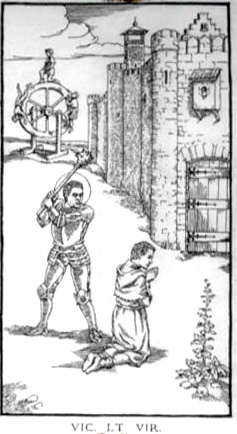 In the background, sits the 'Wheel of Fortune' of the tarot... maybe we should start there. The basic meaning of this card (X)is: DESTINY-TURNING POINT-MOVEMENT-PERSONAL VISION-SUPERIOR FORCES-APPROACHABILITY The Wheel of Fortune is one of the few cards in the major arcana that does not have a human figure as a focal point. This is because its center is above the realm of man - in the higher levels (clouds) where the destinies of all are woven together in the tapestry of life. The tarot recognizes that each person sets his own path in life, but is also subject to the larger cycles that include him. We experience chance events that appear to be accidents although they are part of the great plan.
In readings, the Wheel of Fortune can indicate a vision or realization that strikes with great force. If you've been struggling with a problem or tough situation, this card can signal that you will find the answer if you stand back and view everything from a larger perspective.
The Wheel of Fortune also represents unexpected encounters and twists of fate. You can't predict surprises; you can only be aware when one is circling around. Indeed, Card 10 often suggests wheel-like actions - changes in direction, repeating cycles and rapid movement. When the energy of the Wheel arrives, you will feel life speed up. You are caught in a cyclone that may deposit you anywhere. "Round and round and round she goes, and where she stops, nobody knows."www.learntarot.com/maj10.htmSo... we are dealing in the 'higher realms,' then... and not, probably, the physical realm in which a virtuous man stands to be bludgeoned, which would be a surprise, I'm sure, but... still... The 'questor' is evidently being called to 'overcome' something that looks like 'virtue,' because it is dressed in the 'costume' of 'righteousness,' or a 'holy man.' As we know only too well, the costume does not guarantee the man's virtue, nor does the appearance of the 'halo' around the head of the knight guarantee that his act is done for the sake of righteousness... Suppose that the knight has 'seen through' the 'costume of virtue,' and has decided to do away with that which stands in his way by masquerading as 'untouchable, because holy'... he will then act with the 'halo of righteousness' about his head, becoming a true conqueror, and now very close to his Destiny, as evidenced by the Wheel in the background. How many of us are willing to even consider 'conquering false virtue,' as that 'virtue' has been represented by the historic Church and its heavy yoke of laws? Or even 'virtue' dressed as a 'good' man, which has no real morals, but only the appearance of righteousness, which he wears as a costume as long as it serves him, and is easily stripped off when it does not... or becomes so filthy at last, that he can no longer shelter under it at all... Remember that this is the Eighth illustration... it seems meaningful also that, in the Middle Ages, eight symbolized the perfectioning of incoming planetary energy. The Wheel of Fortune may smile on us, after all...  Read more: innerchamber.proboards.com/thread/644/entering-ninth-gate?page=2#ixzz2dEnVzpWn |
|
|
|
Post by Goldenfleeced on Aug 28, 2013 5:40:54 GMT
And now, if you are ready... I think that I am ready. We will end (or proceed) with illustration number Nine, in which I know now that the shadows come from the Light...This illustration, along with the 'woman,' seems terribly puzzling, and vaguely heretical, somehow... she is naked, and riding a beast, with a castle in the background that is 'lit up;' in the one case, it has been set ablaze and is engulfed in flames... in the other, it is entirely surrounded by the light of a bright star... In her hands, she holds an open book, that she seems to be reading from. In the movie, the castle in the background is referenced as a 'real place,' from which a postcard was sent. On the back of the postcard, we find a description of the place... here it is... It seems to be a picture of the 'Devil's Tower;' shown here to be a castle, which actually exists, and which I will show you shortly. Oddly... coincidentally... there is another Devil's Tower, which is also an actual physical location; it is in South Dakota at the 44th latitude line, which finds its way west to... the Devil's Elbow... hahahaha... right here on the west coast. I actually sit on the 44th latitude line right now... true story. Anyway, that seems serendipitous, to say the least... but there is another 'Tower' which we ought not to overlook at this critical point, I think... and there it is... To add to the 'interest' of this card, at this time, in this place, we find it subtitled 'Le Maison Dieu,' or 'The House of God.' It is being blown to bits in a great conflagration, and serendipitously, I think, the top of the tower resembles a crown that is flying off... and this comes directly after we have successfully 'conquered virtue,' mind you. As to the meaning... well... SUDDEN CHANGE-RELEASE-DOWNFALL-REVELATION: having a revelation- suddenly realizing the truth; exposing what was hidden; having a burst of insight; seeing through illusions; getting the answer; seeing everything in a flash... The illustration certainly bears a great resemblance to descriptions given in the Book of Revelation... I'm sure you've noticed. The problem seems to be in the identity of the woman that is 'riding the beast.' And why... The next thing to consider is the difference between the 'lights' that have engulfed the 'tower' or 'castle;' in the one case, it looks like we really are 'burning down the house,' and in the other, it is an indirect, but hugely bright and encompassing light that has surrounded it. There is an obvious difference in quality, as well as method, of lighting that is going to be critical to completing our little 'path.' And, of course, there is the woman's obvious role in the 'hieros gamos' that is consummated at the end... or beginning... I think I'll take a short break here, and let you contemplate these things before we go on... Speaking of dicey...  Read more: innerchamber.proboards.com/thread/644/entering-ninth-gate?page=2#ixzz2dEtAliYs |
|

 It is quite the 'challenge' to the understanding... in the first place, you may never understand whether she stands in the place of 'good' or 'evil,' or whether she actually incorporates both principles. While it seems that she never directly brings circumstances about, she does most certainly make the most of circumstance as it presents itself, without apology or second thought. It is as it should, or must, be... and, I might add, she wears the Mona Lisa-like smile of the Sphinx. A 'knowing' smile, which is not altogether warm, nor indeed even 'happy,' but... satisfied.
It is quite the 'challenge' to the understanding... in the first place, you may never understand whether she stands in the place of 'good' or 'evil,' or whether she actually incorporates both principles. While it seems that she never directly brings circumstances about, she does most certainly make the most of circumstance as it presents itself, without apology or second thought. It is as it should, or must, be... and, I might add, she wears the Mona Lisa-like smile of the Sphinx. A 'knowing' smile, which is not altogether warm, nor indeed even 'happy,' but... satisfied.
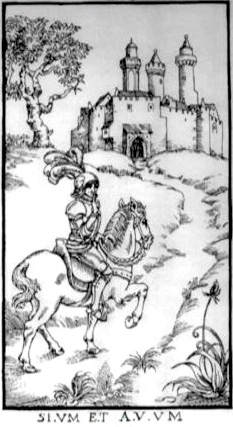
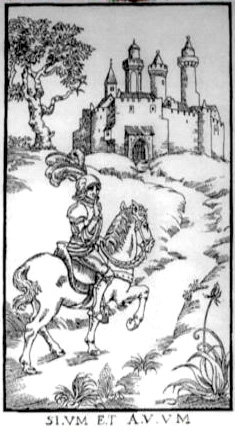

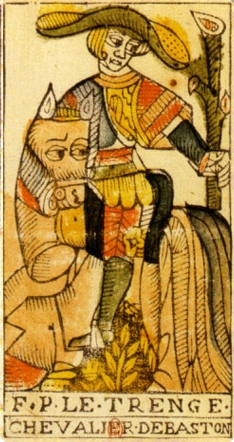


 It is quite the 'challenge' to the understanding... in the first place, you may never understand whether she stands in the place of 'good' or 'evil,' or whether she actually incorporates both principles. While it seems that she never directly brings circumstances about, she does most certainly make the most of circumstance as it presents itself, without apology or second thought. It is as it should, or must, be... and, I might add, she wears the Mona Lisa-like smile of the Sphinx. A 'knowing' smile, which is not altogether warm, nor indeed even 'happy,' but... satisfied.
It is quite the 'challenge' to the understanding... in the first place, you may never understand whether she stands in the place of 'good' or 'evil,' or whether she actually incorporates both principles. While it seems that she never directly brings circumstances about, she does most certainly make the most of circumstance as it presents itself, without apology or second thought. It is as it should, or must, be... and, I might add, she wears the Mona Lisa-like smile of the Sphinx. A 'knowing' smile, which is not altogether warm, nor indeed even 'happy,' but... satisfied.





